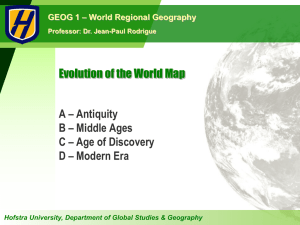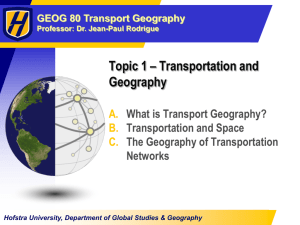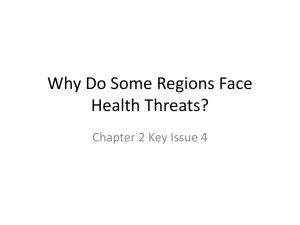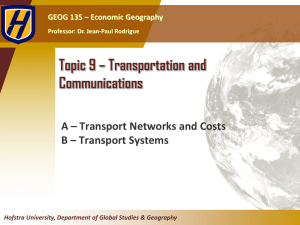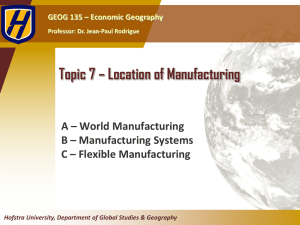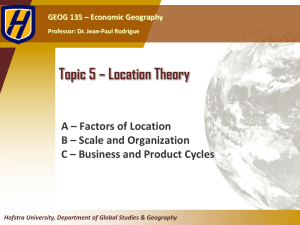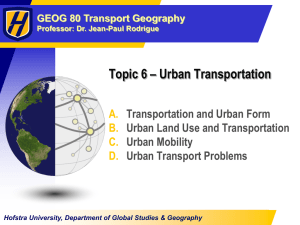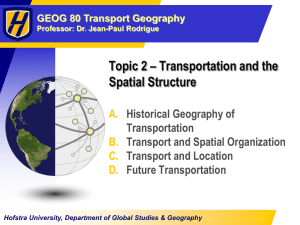The Global Economy - Part II
advertisement
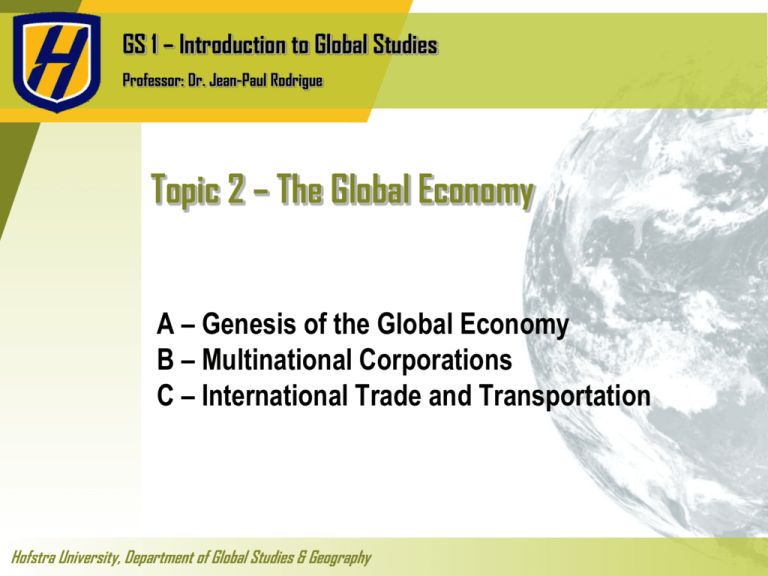
GS 1 – Introduction to Global Studies Professor: Dr. Jean-Paul Rodrigue Topic 2 – The Global Economy A – Genesis of the Global Economy B – Multinational Corporations C – International Trade and Transportation Hofstra University, Department of Global Studies & Geography B – MULTINATIONAL CORPORATIONS Corporations in the Global Economy The Structure of Multinationals Impacts of Multinationals Large Multinational Corporations © Dr. Jean-Paul Rodrigue Corporations in the Global Economy ■ Context • The global economy is organized by trade and infrastructures supporting these exchanges. • Corporations: • • • • • • • Separate legal entity, usually used to conduct business. Main agents generating trade and using the international transport system. Some are generators of movements (producers). Some are attractors of movements (retailers). Some are involved in transportation and distribution. Some provide services (law, accounting). The great majority combine elements of the above. • The territory over which a corporation exercises its influence took a new dimension facing globalization. © Dr. Jean-Paul Rodrigue The Corporation as a Decision, Management and Planning Unit Management Unit Decision Unit Planning Unit Nature Maintain operational conditions. Decisions about the allocation of resources. Anticipate market changes and opportunities. Allocate its factors of production. Scope Production, sales, marketing, payroll, distribution. Financial, labor, raw materials, etc. Economic, technological, social and political change. Time frame Short term (production cycles). Short to long term (product cycles). Medium to long term (business cycles). Read this content © Dr. Jean-Paul Rodrigue Conflicting Elements of a Corporation: Reconciling the Needs of Shareholders, Employees, the Society and Customers • Highest dividend possible. • Share value growth. • Highest compensation. • Various benefits. Shareholders Employees Explain the conflicting elements a corporation is trying to reconcile. Society (State) • Tax collection. • Regulations (wages, benefits, environment, etc.) Customers • Lowest price. • Highest quality. © Dr. Jean-Paul Rodrigue The Structure of Multinationals ■ Multinational corporation (MNC) • Provides goods and/or services. • A corporation that takes a global approach for: • Its inputs (raw materials, parts). • Its outputs (customers). • Different parts of the industrial system are located in places where they are the most productive. © Dr. Jean-Paul Rodrigue What Multinational Corporations Do? Foreign production • Through affiliates located in several countries • Exploitation of comparative advantages Direct control • Policies and activities of affiliate • Different forms of ownership (often stocks) Business strategies • Production, marketing, finance and labor © Dr. Jean-Paul Rodrigue Types of Multinational Corporations by Strategy Raw Materials Seekers • Lower input costs • Resource acquisition • First MNCs to emerge Market Seekers • Achieve economies of scale • Expand market • Large investors in retail and marketing Minimal Cost Seekers • Look for comparative advantages • Lower production and distribution costs • Remain competitive © Dr. Jean-Paul Rodrigue Globally Integrated and Multidomestic Corporation Globally Integrated Corporation Production system located in several countries. Complex products or resources. Interdependency in productivity. Importance of logistics. Multidomestic Corporation Independent operations. Simple products. Production can be integrated globally, while the marketing is multidomestic. Better answer the needs of every market. Independency in productivity. © Dr. Jean-Paul Rodrigue How Multinational Corporations are Competing? Lower production costs • One of the main goals of a corporation. Exploitation of comparative advantages. Stability of prices and deliveries • The rationale of low costs must also take account of price changes of raw materials and parts. Risky to relocate (long-term investment) to take advantage of conditions that can change on the short term. Product quality • Performance, service and maintenance. A quantitatively competitive product has limited advantages if not qualitatively competitive. Production and distribution flexibility • Facing changes in the demand confers a notable advantage. © Dr. Jean-Paul Rodrigue • Less innovative sectors • Mostly financial (holdings) • Outsourcing State support • Resource, technology, product • Technology and Innovation Better management New market opportunity The Growth of Large Multinationals: Three Main Options • Regulatory support or coercion • Large government contracts (e.g. defense corporations) • Corporate socialism © Dr. Jean-Paul Rodrigue The World’s 20 Largest Corporations by Market Value, 2013 ($US millions) Roche China Construction Bank Pfizer Royal Dutch Shell Procter & Gamble Google China Mobile Samsung Johnson & Johnson Industrial & Commerical Bank of China Chevron Nestle IBM Microsoft General Electric Wal-Mart PetroChina Berkshire Hathaway Exxon Mobil Apple Read this content How can the size of a corporation be measured? 0 50,000 100,000 150,000 200,000 250,000 300,000 350,000 400,000 450,000 © Dr. Jean-Paul Rodrigue Short Assignment: The Impacts of Multinationals "(A corporation has) neither body to jail nor soul to damn." - Lord Edward Thurlow (1731-1806) Positive Favor economic growth (employment) Provision of investment capital Provision of goods and services Transfer of technology and skills Increase export opportunities Negative Balance of payments (repatriation of profits) High influence over governments Compete with local businesses Oligopoly / monopoly on local market Leverage (can relocate / threaten to) © Dr. Jean-Paul Rodrigue C – INTERNATIONAL TRADE AND TRANSPORTATION Trade and the Global Economy Global Trade Patterns International Transportation © Dr. Jean-Paul Rodrigue International Trade: A Definition Exchange across national jurisdictions • Goods or services. • Trade between US states is not international trade. Directional • Inbound trade: imports. • Outbound trade: exports. Regulatory oversight • Customs and tariffs. • Nations control what crosses their borders. © Dr. Jean-Paul Rodrigue Trade and the Global Economy Economic efficiency • Sell what is produced in surplus and acquire what is lacking. • Lower productions costs (cheaper inputs). • Achieve economies of scale (larger markets). Accessibility to capital, labor and resources • Large variety of resources being made accessible. • Raw materials, energy, goods, food and labor. • Exchanges of capital, merchandises, raw materials and services. Interdependencies • Spatial interdependencies between elements of the world-system. • The more integrated economies are, the more they trade. • Indirectly promote harmonious relations. © Dr. Jean-Paul Rodrigue Explain the economic rationale of trade Country 1 Country 3 Country 4 Country 3 Country 2 Read this content Country 4 Without Trade Small national markets. Limited economies of scale. High prices and near monopoly. Limited product diversity. Different standards. Country 2 Country 1 Economic Rationale of Trade With Trade Increased competition. Economies of scale. Specialization. Lower prices. Interdependencies © Dr. Jean-Paul Rodrigue Trends Shaping International Trade Ongoing Growth • Value of exports: 48 times in current dollars. GDP 22 times and population 1.8 times. Containerization • Grows at a rate faster than trade and GDP growth. Export-Oriented Economies • Imbalances in trade relations. Multinational Corporations • Vectors of international trade. © Dr. Jean-Paul Rodrigue Share of Product Groups in World Merchandise Trade, 1900-2012 100% 5.0 5.1 4.5 3.4 4.5 3.7 3.1 3.6 66.5 64.1 90% 80% 40.0 40.0 45.0 44.7 70% 52.3 61.0 55.0 70.4 60% 74.8 Other Manufactures Fuels 50% Mining Products 40% 30% Natural Resources Agricultural Products 57.0 54.2 43.6 20% 31.7 10% 26.1 18.1 13.1 10.7 7.8 7.9 9.2 1990 2000 2008 2012 0% 1900 1925 1938 1955 1963 1970 1980 Read this content © Dr. Jean-Paul Rodrigue Modal Shares of World Trade by Volume and Value, 2008 Volume 0.25 Value 9.96 14.32 Seaborne Airborne Overland 89.79 Seaborne Airborne Overland 12.97 72.71 Read this content © Dr. Jean-Paul Rodrigue World’s 20 Largest Exporters and Importers, 2013 Chinese Taipei India Imports Spain Exports Saudi Arabia United Arab Emirates Mexico Singapore Canada Belgium Italy Read this content Russian Federation Hong Kong, China United Kingdom Korea, Republic of France Netherlands Japan Germany United States China 0 500 1000 Billions of USD 1500 2000 2500 © Dr. Jean-Paul Rodrigue American Foreign Trade by Maritime Containers, 2010 (in TEUs) Importers Whirlpool Nike Red Bull General Electric Jarden Ashley Furniture Costco Wholsale JC Penney Ikea Intl. LG Group Samsung Chiquita Philips Heineken Dole Food Sears Holding Lowe's Home Depot Target Wal-Mart Read this content Exporters 64,100 72,300 74,000 76,700 77,100 77,300 83,000 89,900 95,700 101,900 109,100 117,100 127,200 129,000 211,200 212,800 221,600 296,700 455,500 696,000 0 200,000 400,000 600,000 800,000 Eastman Chemical Scoular Cargill Sims Metal Management SDDC Cedarwood-Young Meadwestvaco BASF Delong ExxonMobil Potential Industries Allenberg Cotton Shintech JC Horizon Newport CH Intl Dupont Dow Chemical Weyerhaeuser Koch Industries America Chung Nam 48,100 50,200 51,200 52,200 60,200 60,400 63,700 70,200 75,300 75,500 78,600 78,700 79,800 82,700 93,100 93,600 109,300 113,900 122,400 300,800 0 200,000 400,000 600,000 800,000 © Dr. Jean-Paul Rodrigue Cumulative Waves of Transport Development 17-18th Century 19th Century Read this content 20th Century Air 21st Century Airports Land Punctual inland access Inland and national accessibility Canals Railways Global mobility systems Highways National mobility systems Maritime Sailships Steamships Empires and global trade networks Explain the main transport developments since the 17th century International trade and mobility Containerships Global distribution systems © Dr. Jean-Paul Rodrigue Maritime Shipping Routes and Strategic Locations Read this content © Dr. Jean-Paul Rodrigue World’s Major Container Ports, 2012 Read this content © Dr. Jean-Paul Rodrigue Passenger Traffic at the World’s Largest Airports, 2010 Read this content © Dr. Jean-Paul Rodrigue Freight Traffic at the World’s Largest Airports, 2010 Read this content © Dr. Jean-Paul Rodrigue Global Transport Using the maps on the previous slides, provide an overview of the global transport system such as its main hubs and flows. © Dr. Jean-Paul Rodrigue
